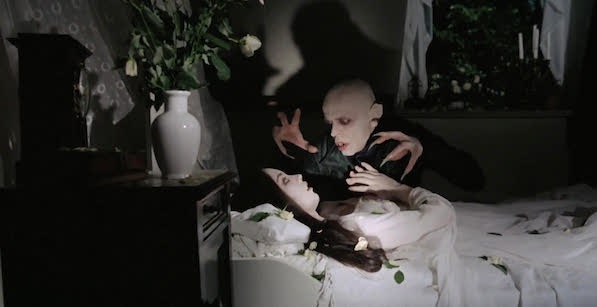As a German filmmaker, we had no real fathers to learn from, no points of reference. Our father’s generation sided with the Nazis or was forced into immigration so we were a generation of orphans. And you can’t work without having some sort of reference as to your own culture and the connection and continuity, so it was our grandfathers–Murnau, Fritz Lang, Pabst and others–who were our teachers, our guidance. For me, Murnau’s film Nosferatu is the best German film ever, and I somehow needed to connect, I had the feeling I had to go back my own roots as a filmmaker. As an homage to him I chose to make this film.”
—Werner Herzog, 1999
One could never accuse Werner Herzog of choosing projects by their commercial prospects. This is, after all, a filmmaker who hypnotized his cast for Heart of Glass and made a documentary about waiting for a volcano to erupt. So the decision to follow up his devastating Stroszek with a remake of a revered masterpiece of world cinema with a cast of international stars—Isabelle Adjani, Bruno Ganz and Klaus Kinski reunited with Herzog for the first time since Aguirre, the Wrath of God—was about more than making money from a vampire movie. (While the film is based more on Murnau’s film than Stoker’s novel, Herzog maintains that is “not a remake, it’s a free version of his Nosferatu…”) It was a tribute, of course, and he kept the title Nosferatu even though he renamed the character Count Dracula (one instance of Stoker over Murnau). It was also a natural subject for a filmmaker who focused on outcasts and obsessives and landscapes rich in natural grandeur and mythic power.
Those landscapes give Herzog’s Nosferatu: Phantom Der Nacht much of its mythic resonance: the town of Delft in the Netherlands, which looks like a 19th-century town preserved in time; the High Tatras mountains and Pernstejn Castle in Eastern Slovakia doubling for Transylvania (Herzog was unable to shoot in Romania); Bavaria, Germany; and Guanajuato, Mexico, where he photographed the mummies displayed the opening scenes. Location was of paramount importance to Herzog. He described it to Roger Ebert as the “voodoo of location:” “I’m good with locations. I know how to do it. It is not just buildings; I direct landscapes.”
20th Century Fox put up some of the money in exchange for American distribution and Herzog shot in both English (alternately titled Nosferatu the Vampyre) and German language editions—it was technically Herzog’s English language debut—but this is a Werner Herzog production, not a Hollywood crossover. He cast the film with European stars and shot it relatively quickly, considering the many locations. Shooting in English was both a commercial and a practical consideration. “As with Aguirre, where we had people from sixteen countries on the set, English was the common language,” he explained to Paul Cronin in the interview book “Herzog on Herzog.” His stars were German and French, with Czech actors and gypsy extras in the Transylvania scenes. “As a filmmaker you have to make a choice, not just to make communication on set easier, but also for the sake of international distributors, and for them English is always the preferred language.” So he shot the film in English, but rather than dub those scenes for the German release, he filmed alternate scenes in German, like Hollywood did in the early days of sound.
The two cuts share a lot of identical footage—the vast crowd scenes, the magnificent shots of Ganz traveling to Dracula’s castle, any long shot that lends itself to easy overdubbing—and the narratives are identical. The differences are subtle and intimate, a matter of performance and minor differences in the editing. For Kinski and Ganz, it meant the chance to perform in their native tongue and it gives their performance a greater ease and confidence. Their English is stiff and deliberate but in German they sound more in command of their words. Adjani, meanwhile, comes across as more overwrought in the English version, even when she’s not speaking. (Adjani also spoke her lines in the German scenes but has to be overdubbed due to her accent and French actor and writer Roland Topor, who played Renfield, was dubbed in both versions, much to Herzog’s dismay; he was sorry to lose Topor’s distinctive giggle.) Herzog cuts the scenes in response to the variations in performance—some shots are held longer in the English version than in the German, and vice-versa—and even rearranges scenes, as if experimenting with variations. And he still ends up with two versions almost identical in running time.
Herzog considers the German language version the “more convincing version,” as he explained to Cronin. “I do not dare speak of the ‘better’ version. I speak of the more ‘culturally authentic’ version.” It is also the preferred version of most of the film’s fans, ostensibly because of those minor differences in performance but perhaps in part because of that cultural authenticity. It feels right to pay tribute to Murnau in his native tongue. But make no mistake: both versions are Herzog’s own. While he did provide a shorter cut of the English-language international version for Fox’s original theatrical release, it has long since been supplanted by Herzog’s original cut. You can make your own comparison; Fandor has both.
“Since I’ve done this film, I’ve always felt now, yes, I’m connected, now I belong to a certain flow of legitimate German culture.” – Werner Herzog, 1999







